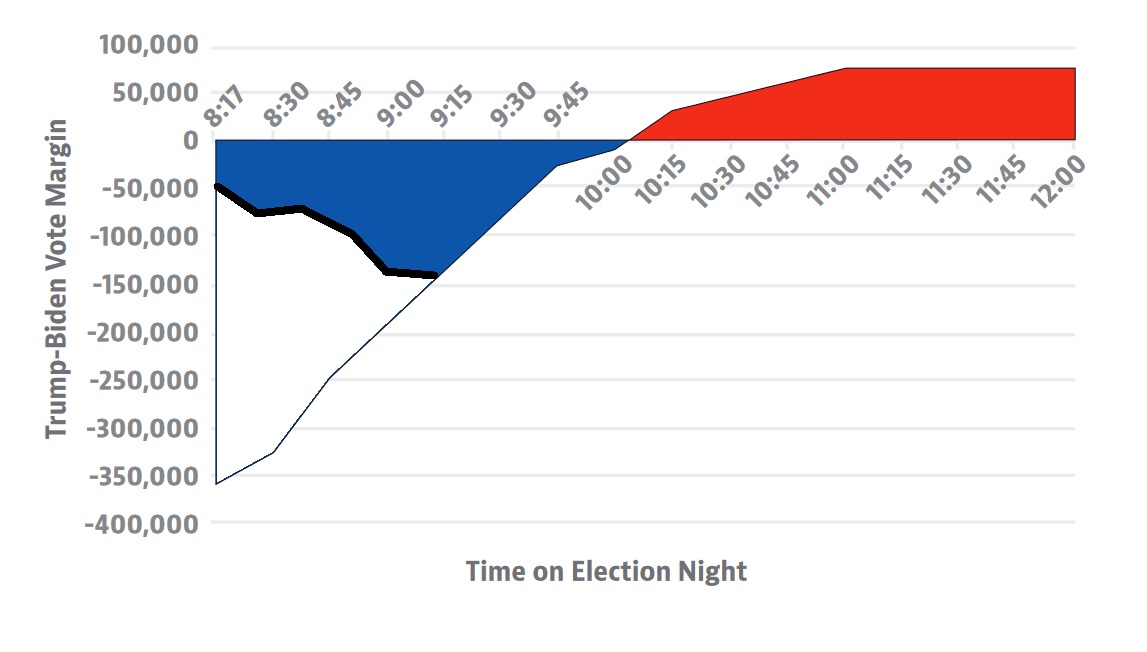Unlike some states, North Carolina has traditionally reported almost all votes on election night. While that tradition will continue, a recent change in state law will shift back when most votes are reported an hour or two.
Early Reporting Made North Carolina a “Red Shift” State
Most North Carolinians vote early or by mail. The North Carolina State Board of Elections (SBE) reported that 53 percent of voters voted early, and five percent voted by mail. The proportion of voters who vote early is even higher in presidential elections; we can expect about two-thirds of voters to vote early in November.
Under state law, election officials tabulated early ballots on the afternoon of election day. They also tabulated all mail ballots they received before election day over the course of several weeks. The county election boards then released both sets of tabulations as soon as polls closed statewide.
Those tabulations are open to the public, although officials cannot share any results until polls close. I had the opportunity to observe early voting tabulations at the McDowell County Board of Elections office during the 11th Congressional District second primary (runoff) in 2020 (see Figure 1).

Democrats tend to take advantage of early voting more than Republicans do. Because early and most mail voting results are reported before precincts can tabulate and report election day results,
As Locke noted in our review of the 2020 election, the result is that North Carolina is a “red shift” state. Democrats traditionally start election night with an apparently insurmountable lead. Republicans then spent the rest of the evening slowly clawing their way back through the evening and pull ahead by 11:00 PM if they were going to pull ahead at all. We would know the winner in all but the closest of races by midnight on election night.
That red shift phenomenon is illustrated by looking at the results of the Trump-Biden race over the course of election night (Figure 2, taken from page 146 of What Happened in 2020?)

A Law Change Will Make Election Night a Little Less Shifty
Senate Bill 747, passed into law in October of 2023, introduced a host of changes to how elections are conducted in North Carolina. One of those changes is to when election officials can tabulate. Section 29 of the law states that the counting of ballots cast “under Part 5 of Article 14A” (i.e., early voting) and counted electronically “shall commence at the time the polls close” (see Figure 3). All early voting ballots are counted with tabulators.

The SBE stated in a press release that they believe county boards to be able to complete early voting tabulations within an hour of the close of polls… but they are not sure, especially since this is their first time operating under the new law:
This process will take an estimated 30 to 60 minutes – and possibly longer in some counties – before unofficial early voting results can be posted publicly on the State Board of Elections’ Election Results Dashboard.
Because the March 5 primary will be the first election held under the new law, election officials do not know exactly how long it will delay the reporting of results. State Board staff will monitor the situation throughout election night and assist county boards of elections if necessary.
How will this affect the results we see on election night?
First, it should have no impact on the results; they are running the same ballots through the same tabulators that they would have under the old law, only a few hours later.
We will also know the winner of almost every race by midnight on election night, just as we did under the old law.
The only real difference is that the pronounced red shift we are used to seeing will diminish. That is because, rather than having almost all early votes reported first, and almost all election day votes reported later, both early and election day tabulations will be released over the course of the evening.
To illustrate how the shift in reporting votes on election night might change, I modified the chart from Figure 2 to reflect that there will not be as big a Democratic advantage at the close of polls this November as there was in recent past elections. The smaller initial Democratic advantage may increase slightly for the first hour or two of reporting before a smaller red shift kicks in about two hours after polls close. As before, Republicans will have to pull ahead by 11:00 PM if they hope to win.
So, assuming that Donald Trump wins again in North Carolina this November, the shift in tabulated votes may look similar to Figure 4.

So, the change in reporting early votes will alter how big North Carolina’s “red shift” is on election night, but we will still go to bed knowing who won most races.


